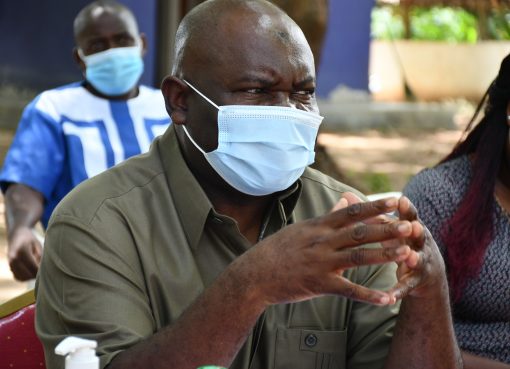Ann Wambui has been battling fibroids for the past six months. Her medical journey has not been easy. It has been expensive and stressful especially when she had to undergo routine pelvic examinations.
“This started when I first experienced a dull pain for a while that later vanished. Next, I experienced an acute abdominal pain radiating to my back. I also noticed I had gained weight, urinated frequently and I used to bleed profusely during my menstrual dates. That’s when I decided to go for a medical checkup.
“After the doctor’s examination, I was sent to a radiologist who conducted a pelvic scan and gave a summary report indicating that I had pedunculated fibroids that appeared to be hanging in my uterus,” sobbed Wambui.
The results were traumatizing to the 30-year-old, who knew too well that her financial status could not sustain a prescribed routine pelvic exam after every two weeks.
“The doctor told me that I had to undergo surgery to remove the abnormal mass in my uterus which was done successfully,” she told KNA at Nyahururu County Referral Hospital bed, where she was recovering hoping that the problem was conclusively dealt with.
She urges women to seek medical attention immediately they experience unusual pains or changes in their bodies.
Another patient, Mary Atieno, told KNA that she was still fighting ovarian cysts, even though she is expectant currently. She stated that she has been suffering from the said problem since she was 18 years of age.
“When I was 18, I started having painful cramps and inflammatory back pain that was always inconsistent. Even after I conceived, I experienced the same painful cramps and consulted medics who classified my pregnancy as high risk.
“I therefore required frequent examination and was introduced to pain management drugs to suppress the excruciating pain until my baby reached full-term,” said Atieno.
Fibroids and Ovarian Cysts have become a common health issue in women, affecting 70 to 80 percent of those in their child bearing age.
According to Dr Tom Victor Waweru of AMPO Medical Clinic Nyahururu, the difference between the two is that fibroids, which are non-cancerous abnormal growths of the uterus and develop in the muscular lining of the uterus.
Cysts on the other hand take the form of semisolid fluid-filled blisters and form in or on the ovaries.
“Fibroids grow in different parts. There are those that develop in uterine walls and are called submucosal fibroids, others form in between the uterine walls and are referred to as intramural fibroids. Pedunculated fibroids appear hanging in the outer side of the uterine walls because they have grown extensively. These are the common types of fibroids cases that have been diagnosed recently,” he explained.
“Fibroids have no particular cause although there are risk factors that are hereditary. Besides some hormones and infertility, it can also cause the growth of the abnormal mass in the uterus,” adds Dr Waweru.
“There are several signs and symptoms that guide the doctor such as vaginal bleeding that can cause anaemia and lower abdominal pain which radiates to the back. Sometimes when fibroids have overgrown, one can experience frequent urination if it presses the bladder. The patient may also experience pain and bleeding while having intercourse,” he added.
The doctor advises patients to go for an ultrasound of either the abdominal pelvic or the pelvic scan adding however that the diagnosis is only done if the symptoms are crystal clear and the patient is enrolled in clinical checks and medication.
“Where there are no said symptoms, most women realize they have fibroids when it has overgrown. We treat patients by giving them painkillers to subside the pains. Progesterone, which is a hormonal medicine that stops the bleeding, is also administered to make sure the patient is as comfortable as possible.
If the patient is pregnant, we introduce her to pain meds until she is due for delivery. We also manage the overgrown fibroids of about 6cm and above by conducting a surgery known as the myomectomy that is used to remove the fibroids to the level of myometrium,” Dr Waweru went on.
“Apart from the surgery, there is a uterine artery that supplies blood to the fibroids which is clipped by a process known as embolization which then prevents the fibroids from getting nutrients and oxygen and hence, they shrink and eventually die,” he adds.
Waweru regrets that women with fibroids history tend to experience miscarriages if they had undergone several surgeries as they weakened their uteruses explaining: “Patients who undergo the process of medication, hormonal therapy, surgery and combined oral contraceptives have reduced chances of fibroids recurring after treatment.”
Ovarian cysts are commonly experienced before menopause and are typically linked to menstrual cycle according to Dr Humphry Njenga, a General Practitioner.
“Ovarian cysts are said to have no specific cause but there are several risk factors that can lead to their occurrence. There is no described age for developing the ovarian cysts because it affects even children of less than a week as a result of the mother having hormone imbalance that causes the withdrawal of maternal hormones leading to bleeding,” Dr Njenga said.
“The risk factors associated with cysts include hormones, withdrawal of maternal hormones to a female child, oral combined contraceptive pills that are used to manage infertility and cigarette smoking,” said Njenga.
He spelt out several signs and symptoms that enable him to determine the suitable diagnosis. “These symptoms include excruciating pelvic pain especially when on periods, abdominal bloating, pain during intercourse and one-sided abdominal pain on a specific affected side. The severe pains may cause the patient to feel nauseous or even vomit.” he stressed.
He further explained that in case of a ruptured cyst which is a medical emergency, the fluid released is cleaned to prevent infections adding the same is diagnosed by carrying out an ultrasound specifically on the pelvic area.
“Most times, we do not operate on cysts unless it is 6cm wide and above, less than that requires a conservative management. Cysts are not cancerous. Ovarian cysts occur only when ovulation is taking place,” he explained.
Dr Njenga said most ovarian cysts resolve without treatment adding: “However, if they are large enough and left untreated, they may interfere with conception or cause severe damage that leads to infertility,” concludes Dr Njenga.
By Judy Nderitu and Julita Robi




